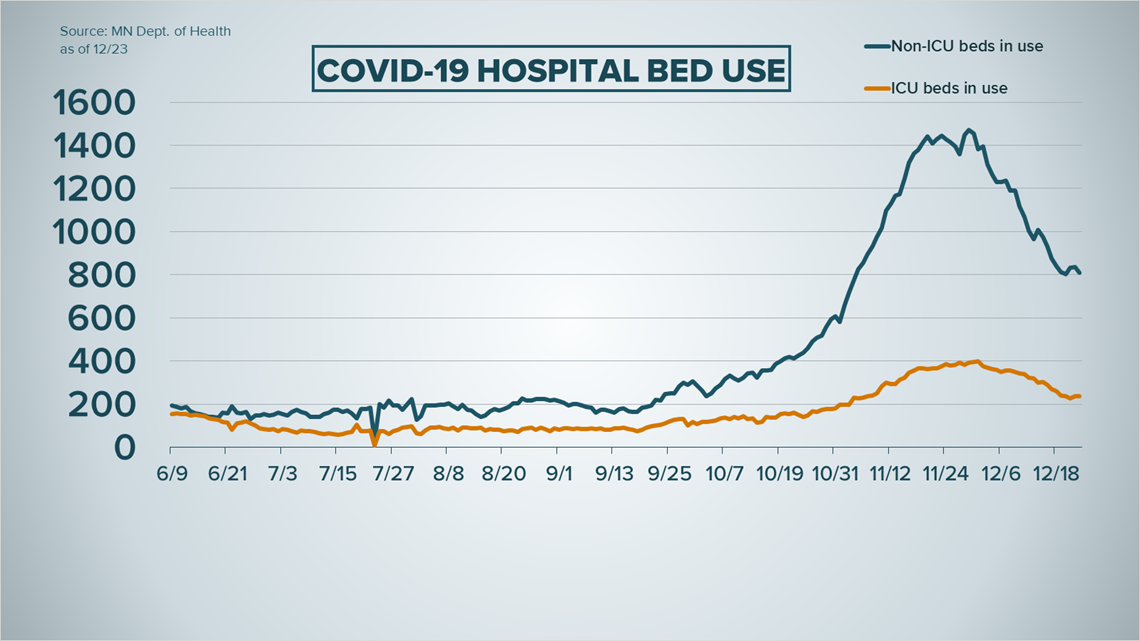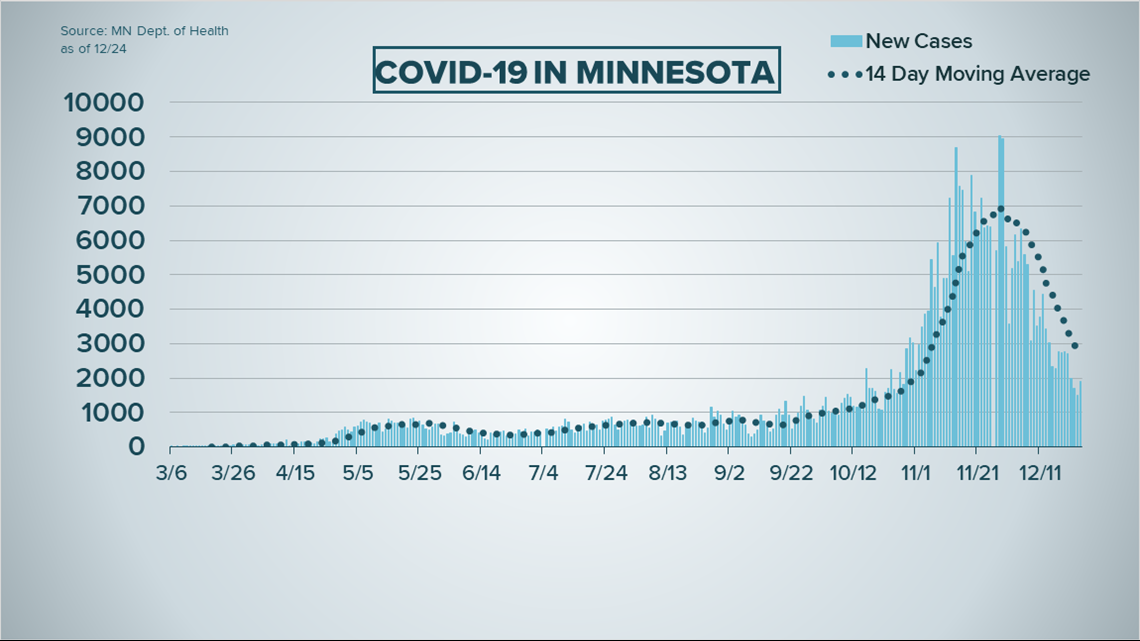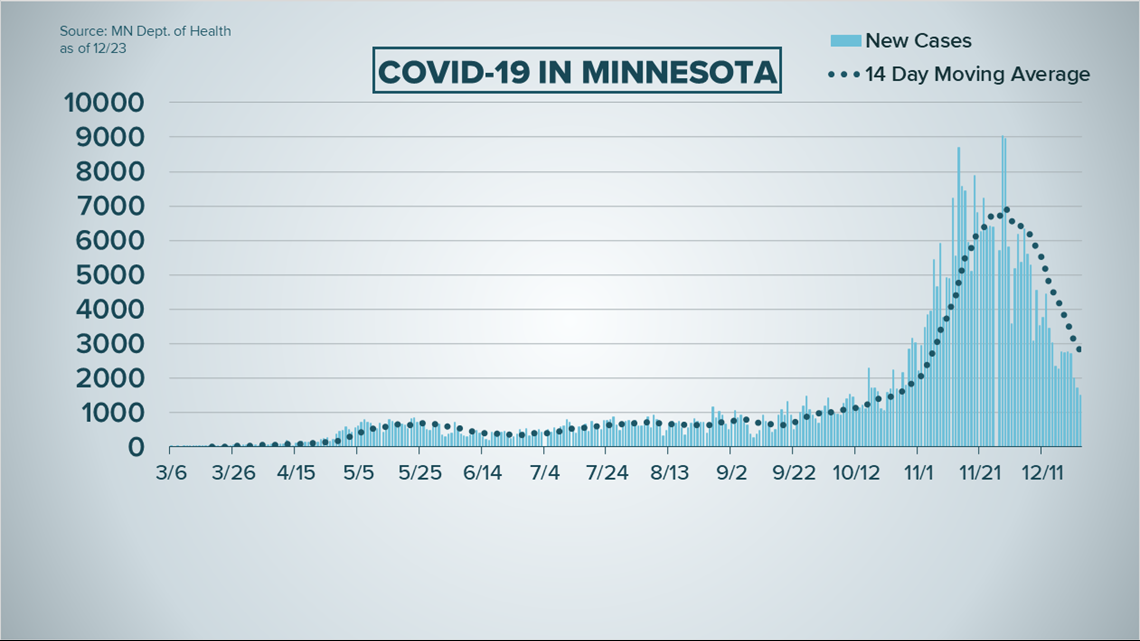ST PAUL, Minn. — Sunday, Dec. 27
- MDH reported 2,543 news cases, 40 new deaths
- Wisconsin reported 2,287 new cases, 9 new deaths
2 p.m.
The Wisconsin's Department of Health Services (WDHS) reported 2,287 new cases Sunday, bringing the total number of cases statewide to 470,818.
Health officials reported nine new deaths on Sunday as the total number of fatalities in Wisconsin rose to 4,692, which is approximately 1% of those testing positive for the virus.
Wisconsin health officials say a total of 20,829 people have been hospitalized from the coronavirus since the start of the pandemic, about 4.4% of the total number of people who have been diagnosed with the virus.
Of the confirmed cases in Wisconsin, 19% involve people between the ages of 20 to 29, 16% are between 30 and 39, 15% are between 50 and 59, and 14% are 40 to 49. An estimated 11% are between 10 and 19, and another 11% are between 60 and 69.
As of Sunday, Milwaukee County reported the largest number of confirmed cases with 83,127, along with 955 deaths. Waukesha County has reported 33,265 confirmed cases and 327 deaths, Dane County has reported 32,555 confirmed cases and 176 deaths, and Brown County has reported 25,654 cases and 160 deaths.
A more detailed breakdown of cases by county can be found on the DHS website.
The first positive case of COVID-19 coronavirus in Wisconsin was reported in a patient in Dane County in early February.
The first case in Minnesota was confirmed on March 6.
11 a.m.
The Minnesota Department of Health (MDH) reported 2,534 new COVID-19 cases Sunday, along with 40 new deaths.
MDH's COVID-19 case definition includes both antigen testing and polymerase chain reaction (PCR) testing. Positive PCR test results are considered confirmed cases, while positive antigen test results are considered probable cases.
Sunday's new case total includes 2,335 confirmed cases and 199 probable cases.
The total number of Minnesotans who have tested positive for the virus since the pandemic began is now 409,061, with 13,348 of those as antigen test results.
MDH says 40 new deaths from the virus were reported. That pushes the total number of fatalities in Minnesota to 5,147.
To date, 21,315 Minnesotans have been hospitalized with the coronavirus since the pandemic started, with 4,527 of them needing care in the ICU.
MDH reports that 388,919 people once diagnosed with the virus have recovered enough that they no longer need isolation.
Of those who have tested positive, people between the ages of 20-24 account for the most cases with 41,738 cases and three deaths, and ages 25-29 follow with
36,717 cases and six deaths. Those between 85 and 89 years old account for the highest number of fatalities in one age group with 977 out of 5,430 cases.
In terms of likely exposure to the coronavirus, MDH says 85,869 cases were the result of community transmission with no known contact with an infected person, and 79,157 had known contact with a person who has a confirmed case.
A total of 33,855 cases involved exposure in a congregate living setting,
7,039 were in a corrections setting, and 850 were in a homeless shelter. MDH data shows 17,403 were linked to an outbreak outside of congregate living or health care.
MDH says 25,241 cases were linked to travel. Health care workers or patients account for 11,836 of diagnosed COVID-19 cases. The source of transmission for 147,811 cases is still unknown or missing.
MDH has prioritized testing for people in congregate care, hospitalized patients and health care workers, which may impact the scale of those numbers. However, now MDH is urging anyone who is symptomatic or even asymptomatic to be tested. Testing locations can be found online.
Hennepin County has the most COVID activity in the state with 85,143 cases and 1,357 deaths, followed by Ramsey County with 36,582 cases and 663 deaths, Dakota County with 29,727 cases and 269 deaths and Anoka County with 28,635 cases and 317 deaths.
Full data, including a breakdown of PCR and antigen test totals in some categories, can be found on MDH's website.
Saturday, Dec. 26
2 p.m.
Wisconsin's Department of Health Services (WDHS) reported 632 new cases Saturday, bringing the total number of cases statewide to 468,531.
This is the first time the daily case count has fallen below 1,000 since Sept. 14, which totaled 771 cases.
Health officials reported four new deaths on Saturday as the total number of fatalities in Wisconsin rose to 4,683, which is approximately 1% of those testing positive for the virus.
Wisconsin health officials say a total of 20,734 people have been hospitalized from the coronavirus since the start of the pandemic, about 4.4% of the total number of people who have been diagnosed with the virus.
Of the confirmed cases in Wisconsin, 19% involve people between the ages of 20 to 29, 16% are between 30 and 39, 15% are between 50 and 59, and 14% are 40 to 49. An estimated 11% are between 10 and 19, and another 11% are between 60 and 69.
As of Saturday, Milwaukee County reported the largest number of confirmed cases with 82,875, along with 955 deaths. Waukesha County has reported 33,154 confirmed cases and 327 deaths, Dane County has reported 32,375 confirmed cases and 176 deaths, and Brown County has reported 25,566 cases and 160 deaths.
A more detailed breakdown of cases by county can be found on the DHS website.
11 a.m.
The Minnesota Department of Health (MDH) reported 2,170 new COVID-19 cases Saturday, along with 57 new deaths.
MDH's COVID-19 case definition includes both antigen testing and polymerase chain reaction (PCR) testing. Positive PCR test results are considered confirmed cases, while positive antigen test results are considered probable cases.
Saturday's new case total includes 1,968 confirmed cases and 202 probable cases.
The total number of Minnesotans who have tested positive for the virus since the pandemic began is now 406,545, with 13,154 of those as antigen test results.
MDH says 57 new deaths from the virus were reported. That pushes the total number of fatalities in Minnesota to 5,107.
To date, 21,213 Minnesotans have been hospitalized with the coronavirus since the pandemic started, with 4,516 of them needing care in the ICU.
MDH reports that 382,705 people once diagnosed with the virus have recovered enough that they no longer need isolation.
Of those who have tested positive, people between the ages of 20-24 account for the most cases with 41,544 cases and three deaths, and ages 25-29 follow with
36,468 cases and six deaths. Those between 85 and 89 years old account for the highest number of fatalities in one age group with 968 out of 5,390 cases.
In terms of likely exposure to the coronavirus, MDH says 85,299 cases were the result of community transmission with no known contact with an infected person, and 78,621 had known contact with a person who has a confirmed case.
A total of 33,605 cases involved exposure in a congregate living setting,
7,022 were in a corrections setting, and 848 were in a homeless shelter. MDH data shows 17,403 were linked to an outbreak outside of congregate living or health care.
MDH says 25,058 cases were linked to travel. Health care workers or patients account for 11,747 of diagnosed COVID-19 cases. The source of transmission for 146,942 cases is still unknown or missing.
Hennepin County has the most COVID activity in the state with 84,526 cases and 1,351 deaths, followed by Ramsey County with 36,339 cases and 661 deaths, Dakota County with 29,528 cases and 266 deaths and Anoka County with 28,436 cases and 312 deaths.
Friday, Dec. 25
- Wisconsin health officials reported 5 deaths, fewest since Nov. 22
- Wisconsin reported 1,506 new cases
- MDH did not provide a COVID update for Dec. 25
2 p.m.
The Wisconsin Department of Health Services reported five new coronavirus-related deaths on Friday, marking the fewest single-day deaths statewide since Nov. 22.
Since the pandemic began, Wisconsin has had 4,679 total deaths, which is approximately 1% of those testing positive for the virus.
Health officials also reported 1,506 new cases in Wisconsin, bringing the total number of cases to 467,899.
The Minnesota Department of Health didn't provide a COVID-19 update on Friday, but is expected to release the latest numbers on Saturday.
Wisconsin health officials say a total of 20,703 people have been hospitalized from the coronavirus since the start of the pandemic, about 4.4% of the total number of people who have been diagnosed with the virus.
Of the confirmed cases in Wisconsin, 19% involve people between the ages of 20 to 29, 16% are between 30 and 39, 15% are between 50 and 59, and 14% are 40 to 49. An estimated 11% are between 10 and 19, and another 11% are between 60 and 69.
As of Friday, Milwaukee County reported the largest number of confirmed cases with 82,716, along with 955 deaths. Waukesha County has reported 33,154 confirmed cases and 327 deaths. Dane County has reported 32,374 confirmed cases and 176 deaths, and Brown County has reported 25,565 cases and 160 deaths.
Thursday, Dec. 24
2 p.m.
Minnesota has reached another grim milestone in the ongoing COVID-19 pandemic, passing the threshold of 5,000 lives lost to the virus.
Numbers released Thursday by the Minnesota Department of Health (MDH) reflect 79 fatalities in the past day, bringing the state's death toll to 5,050 since the start of the pandemic. Deaths have remained high across the state, even while the number of cases has been trending down since the massive spike in late November and early December.
MDH recorded 1,917 new coronavirus cases in the last 24-hour reporting period, 400 more than were reported Wednesday, but still significantly lower than in recent weeks. Those new cases are based on the results of 51,675 tests (46,982 PCR, 4,693 Antigen) processed in private and state labs.
Health officials consider a positive PCR test a confirmed COVID case, while a positive Antigen test is labeled as probable.
Currently 1,048 hospital beds across the state are filled with coronavirus patients, with 238 of those in the ICU. In the Twin Cities metro the percentage of open beds remains lower than health officials would like to see: Only 4.3% of non-ICU beds (160) are open as of Thursday, and 39 ICU beds (5.7%) are available. Total hospitalizations since the onset of the pandemic are now at 21,105, with 4,500 of those patients requiring care in the ICU.


Of the Minnesotans who have tested positive for COVID-19, 381,269 have recovered to the point they no longer require isolation.
Young adults continue to account for the largest group of infections, with people from 20 to 24 representing 41,370 cases and three fatalities, while those 25 to 29 number 36,282 cases and six deaths.
The largest grouping of fatalities involves Minnesotans from 85 to 89, with 960 deaths in just 5,346 diagnosed cases.


Hennepin County has recorded the most COVID activity in Minnesota with 84,116 cases and 1,345 deaths, followed by Ramsey County with 36,203 cases and 654 deaths, Dakota County with 29,355 cases and 262 deaths, and Anoka County with 28,326 cases and 307 fatalities.
Cook County in northeastern Minnesota has seen the least COVID activity with 102 cases and zero deaths.
Wednesday, Dec. 23
2 p.m.
State health officials said Wednesday that some delays on Moderna vaccine shipments nationally will impact Minnesota, and a winter storm could exacerbate the situation.
Minnesota Department of Health (MDH) Infectious Disease Director Kris Ehresmann said on a media briefing call Wednesday that when MDH became aware of the shipping delays, they began reaching out to providers.
They found that four providers in Minnesota have been informed that their vaccine shipments will be delayed, and weather will complicate that as well. MDH will provide updates to the public as they become available.
Ehresmann also announced Wednesday that MDH now has a publicly accessible page giving information on vaccines coming to Minnesota at mn.gov/covid19.
Ehresmann pointed out that there is lag time between when the vaccine doses are allocated to Minnesota, delivered, administered and then reported. She said while the website shows 2,999 doses administered today, MDH has preliminary data that more than 11,500 doses have already been administered in Minnesota.
MDH Commissioner Jan Malcolm said on the call that COVID-19 spread continues at an “unabated pace” nationally and globally. In Minnesota, however, case numbers continue dropping from their November peak, with the lowest daily count since Oct. 21 reported on Wednesday.
"Happy to say that the data continues to show some encouraging trends," Malcolm said, though deaths continue at a "heartbreaking pace."
Malcolm said Minnesota will likely cross the threshold of 5,000 deaths from the virus on Christmas Eve.
"What a sad time of year to think about 5,000 families not having their loved ones with them," she said.
Malcolm said it's important to remember that although Minnesota's case numbers are going down relative to the state's peak, the numbers are still high when compared with many other places in the country.
MDH Infectious Disease Director Kris Ehresmann said that since hospitalization and death numbers are lagging significantly from case numbers, the high rates of death Minnesota is seeing in December are a result of the peak case numbers back in November.
"As we were looking at the highest case numbers in November, we were seeing our deaths increase, but we weren't seeing the highest deaths in November," she said. "We've had a December with the highest death counts. And that's because in December we are sort of reaping the results of the high November rates."
Ehresmann said she hopes that January death numbers will decrease as a result of declining cases in December.
Malcolm said that Minnesotans' hard work to take prevention guidelines seriously is having a positive impact on the COVID-19 situation statewide.
"For that we thank you, and your neighbors thank you," she said. "This is important not just to protect yourself and your immediate family."
Malcolm asked Minnesotans to limit indoor social gatherings to two households with no more than 10 people, and maintain social distance. Outdoor gatherings are limited to 15 people with no more than three households.
"Now is not the time to let down our guard, and these numbers have fallen because of what we've done," Malcolm said. "It's important to keep paying attention."
11 a.m.
New COVID-19 cases in Minnesota continue to drop, but deaths again spiked on Wednesday.
According to the Minnesota Department of Health, 75 people died of the coronavirus in the past day. That's more than three times the daily totals on Monday and Tuesday, but numbers of deaths have frequently been in the 70s and higher over recent weeks, even with cases dropping.
On Wednesday, MDH reported 1,513 new cases of the coronavirus. Of those, 1,207 were identified by PCR test - considered confirmed, and 306 by antigen test - considered probable. That's the lowest number of new cases in over two months, since 1,068 new confirmed PCR cases were reported on Oct. 21.


Testing numbers were down considerably over the past 24-hour reporting period as well, with 17,952 PCR tests and 5,611 antigen tests performed across the state. That's the lowest testing volume since Dec. 15.
Statewide hospitalizations due to COVID-19 have generally been trending downward for the month of December, but they were up as of Tuesday, the latest data available. In the metro, 6.3% of staffed ICU beds are available, and only 3.2% of non-ICU beds are available.
Gov. Tim Walz signed an executive order Wednesday reopening pools for lap swim and organized swim team sports beginning Monday, Jan. 4, 2021. Walz's order specifies that facilities must follow social distancing requirements that are specific to pools and can be found in the Stay Safe Minnesota guidance.
MDH is expected to hold a briefing call at 2 p.m. Wednesday to update the public on COVID-19 spread in Minnesota and recommendations for holiday safety.
KARE 11’s coverage of the coronavirus is rooted in Facts, not Fear. Visit kare11.com/coronavirus for comprehensive coverage. Have a question? Text it to us at 763-797-7215. And get the latest coronavirus updates sent right to your inbox every morning. Subscribe to the KARE 11 Sunrise newsletter here. Help local families in need: www.kare11.com/give11.
The state of Minnesota has set up a data portal online at mn.gov/covid19.

